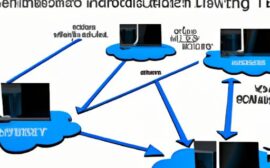Introduction
In the world of technology, two giants stand tall: cloud computing and on-premise solutions. But what exactly do these terms mean? Cloud computing refers to the delivery of computing services over the internet, allowing for flexible and scalable resources. On the other hand, on-premise solutions involve hosting and managing software on local servers within the organization. Understanding the cost disparities between these two options is crucial for businesses looking to make informed decisions that align with their budget and operational needs.
As we delve deeper into the realm of cloud vs on-premise cost analysis, we’ll uncover the intricate web of factors that play a role in determining the financial implications of each choice. Join me on this journey as we navigate through the complexities of cost structures and considerations, shedding light on the path towards cost-effective and efficient IT solutions.
Cloud Computing Cost Analysis
Overview of Cloud Computing Cost Structure
When it comes to cloud computing, the cost structure is dynamic and adaptable, offering businesses the flexibility to scale resources up or down based on demand. Cloud providers typically charge based on usage, storage, bandwidth, and additional services, allowing organizations to pay for what they need without the burden of upfront investments in hardware and infrastructure.
Factors Affecting Cloud Computing Costs
Several factors influence cloud computing costs, including the type and amount of resources utilized, data transfer fees, storage requirements, and the level of service and support needed. Understanding these variables is essential for businesses to optimize their cloud spending and ensure cost efficiency in the long run.
Benefits of Pay-As-You-Go Pricing Model
One of the key advantages of cloud computing is the pay-as-you-go pricing model, which enables businesses to only pay for the resources they use. This flexible approach allows for cost control and scalability, as organizations can easily adjust their usage based on changing needs without being locked into fixed contracts or commitments. By leveraging the pay-as-you-go model, businesses can optimize their cloud spending and align costs with actual usage, maximizing cost-effectiveness and operational efficiency.
On-Premise Solutions Cost Analysis
Overview of Cost Structure for On-Premise Solutions
When it comes to on-premise solutions, the cost structure is significantly different from cloud computing. Organizations that opt for on-premise solutions typically incur upfront costs for hardware, software licenses, and infrastructure setup. These initial investments can be substantial, requiring careful budget planning and resource allocation. Additionally, ongoing operational costs, such as maintenance, upgrades, and support, contribute to the overall cost of on-premise solutions.
Factors Affecting On-Premise Solution Costs
Several factors influence the total cost of implementing and maintaining on-premise solutions. The size and complexity of the organization, the scope of the software applications, and the level of customization required all play a role in determining costs. Furthermore, scalability and future expansion need to be considered to ensure that the on-premise infrastructure can accommodate growth without incurring excessive expenses.
Considerations for Hardware and Software Maintenance Costs
One of the key cost considerations for on-premise solutions is hardware and software maintenance. Regular maintenance activities, such as updates, patches, and troubleshooting, are essential to keep the system running smoothly and securely. Hardware upgrades and replacements may also be necessary to ensure optimal performance and compatibility with evolving technology standards. Balancing these maintenance costs with the benefits of on-premise control and security is paramount in making cost-effective IT decisions.
Cost Comparison: Cloud vs On-Premise
Total Cost of Ownership Analysis
When comparing cloud computing to on-premise solutions, one of the key factors to consider is the total cost of ownership (TCO). Cloud computing often boasts lower upfront costs due to its pay-as-you-go pricing model, which eliminates the need for significant initial investments in hardware and infrastructure. On the other hand, on-premise solutions may require a substantial upfront capital expenditure for hardware and software licenses, potentially inflating the TCO over time.
Cost Savings Potential with Cloud Computing
Cloud computing offers businesses the opportunity to realize significant cost savings through scalability and efficiency. With the ability to scale resources up or down based on demand, businesses can avoid over-provisioning and paying for unused capacity. Additionally, cloud providers typically handle maintenance, updates, and security, reducing the burden on internal IT teams and minimizing associated costs.
Factors to Consider when Deciding
When weighing the pros and cons of cloud vs on-premise solutions, several factors come into play. Considerations such as scalability, security, compliance requirements, data residency, and long-term cost projections must be evaluated to make an informed decision. By conducting a thorough analysis of these factors and understanding the implications on cost and operational efficiency, businesses can choose the IT solution that best aligns with their strategic objectives.
Case Studies
Companies Opting for Cloud Solutions
When considering cost implications, many companies have turned to cloud solutions as a cost-effective alternative to traditional on-premise setups. Take Company X, for instance, a startup looking to scale rapidly without the burden of hefty upfront investments in hardware and infrastructure. By opting for cloud services, Company X was able to leverage pay-as-you-go pricing models, significantly reducing initial capital expenditures and allowing for seamless scalability as their business grew.
On-Premise Solutions in Practice
Conversely, some established enterprises, like Company Y, have chosen to stick with on-premise solutions due to specific cost considerations. Company Y, a financial institution with stringent security and compliance requirements, found that hosting sensitive data on local servers provided them with greater control and customization options, albeit at a higher initial cost. The decision to maintain an on-premise setup allowed Company Y to align their IT infrastructure with industry regulations while ensuring business operations ran smoothly without compromising data security.
Conclusion
In conclusion, the comparison between cloud and on-premise solutions in terms of cost is a multifaceted decision that requires careful consideration and analysis. By weighing the total cost of ownership, scalability, maintenance expenses, and other key factors, businesses can make informed choices that align with their financial goals and operational requirements.
As technology continues to evolve, the importance of understanding the cost implications of cloud vs on-premise solutions cannot be overstated. By staying informed, monitoring costs, and continuously optimizing IT strategies, organizations can navigate the complexities of the digital landscape while maximizing efficiency and profitability. Remember, the right choice between cloud and on-premise solutions ultimately depends on your unique business needs and budget constraints. Make sure to evaluate all aspects thoroughly to make the best decision for your organization’s success.



